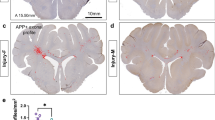Abstract
Background
Syndromic craniosynostosis (SC) is associated with a high prevalence of sleep-disordered breathing (SDB). However, it remains unclear whether non-syndromic craniosynostosis (NSC) is associated with an increased risk for SDB.
Setting
This study was conducted at a tertiary referral pediatric medical center.
Methods
A prospective polysomnographic (PSG) evaluation was conducted of all children diagnosed with craniosynostosis over a 3-year period and who had not undergone previous PSG for SDB-related symptoms.
Results
Among 14 children fulfilling inclusion criteria, 10 had NSC and 4 were diagnosed with SC (Crouzon syndrome). SDB was present in 50 % of the NSC and in 75 % of SC. No associations emerged between the number of sutures affected and the presence of SDB.
Conclusions
SDB is highly prevalent not only in SC but also among asymptomatic children with NSC. The diagnosis of NSC should prompt a diagnostic PSG as a routine component of the clinical evaluation, and PSG findings may aid in the formulation of decisions regarding timing and need for surgical interventions.

Similar content being viewed by others
References
Cohen MM Jr (1990) Anomalies, syndromes and dysmorphic growth. In: Enlow DH (ed) Facial growth, 3rd edn. Saunders, Philadelphia, pp 331–345
Jones KL (2006) Smith’s recognizable patterns of human malformations. Elsevier Saunders, St. Louis
Noorily MR, Farmer DL, Belenky WM, Philippart AI (1999) Congenital tracheal anomalies in the craniosynostosis syndromes. J Pediatr Surg 34:1036–1039
Peterson-Falzone SJ, Pruzansky S, Parris PJ, Laffer JL (1981) Nasopharyngeal dysmorphology in the syndromes of Apert and Crouzon. Cleft Palate J 18:237–250
Cohen MM Jr, Kreiborg S, Lammer EJ, Cordero JF, Mastroiacovo P, Erickson JD, Roeper P, Martínez-Frías ML (1992) Birth prevalence study of the Apert syndrome. Am J Med Genet 42:655–659
Cohen MM Jr, Kreiborg S (1992) Birth prevalence studies of the Crouzon syndrome: comparison of direct and indirect methods. Clin Genet 41(1):12–15
Shuper A, Merlob P, Grunebaum M, Reisner SH (1985) The incidence of isolated craniosynostosis in the newborn infant. AmJ Dis Child 39:85–86
Singer S, Bower C, Southall P, Goldblatt J (1999) Craniosynostosis in Western Australia, 1980–1994: a population-based study. Am J Med Genet 83:382–387
Gonsalez S, Hayward R, Jones B, Lane R (1997) Upper airway obstruction and raised intra- cranial pressure in children with craniosynostosis. Eur Respir J 10:367–375
Hoeve LJ, Pijpers M, Joosten KF (2003) OSAS in craniofacial syndromes: an unsolved problem. Int J Pediatr Otorhinolaryngol 67:111–113
Moore MH (1993) Upper airway obstruction in the syndromal craniosynostosis. Br J Plast Surg 46:355–362
Pijpers M, Poels PJ, Vaandrager JM, de Hoog M, van den Berg S, Hoeve HJ, Joosten KF (2004) Undiagnosed obstructive sleep apnoea syndrome in children with syndromal craniofacialsynostosis. J Craniofac Surg 15:670–674
Schafer ME (1982) Upper airway obstruction and sleep disorders in children with craniofacial anomalies. Clin Plast Surg 9:555–567
Sculerati N, Gottlieb MD, Zimbler MS, Chibbaro PD, McCarthy JG (1988) Airway management in children with major craniofacial anomalies. Laryngoscope 108:1806–1812
Sirotnak J, Brodsky L, Pizzuto M (1995) Airway obstruction in the Crouzon syndrome: case report and review of the literature. Int J Pediatr Otorhinolaryngol 31:235–246
Al-Saleh S, Riekstins A, Forrest CR, Philips JH, Gibbons J, Narang I (2011) Sleep related disordered breathing in children with syndromic craniosynostosis. J Cranio-Maxillo-Facial Surg 39:153–157
No authors listed (1996) Standards and indications for cardiopulmonary sleep studies in children. American Thoracic Society. Am J Respir Crit Care Med 153:866–878
Montgomery-Downs HE, O’Brien LM, Gulliver TE, Gozal D (2006) Polysomnographic characteristics in normal preschool and early school-aged children. Pediatrics 117:741–753
Iber C, Ancoli-Israel S, Chesson AL, Quan SF (2007) The AASM manual for the scoring of sleep and associated events. American Academy of Sleep Medicine, Westchester
Arens R, Marcus CL (2004) Pathophysiology of upper airway obstruction: a developmental perspective. Sleep 27(5):997–1019
Speltz ML, Kapp-Simon K, Collett B, Keich Y, Gaither R, Cradock MM, Buono L, Cunningham ML (2007) Neurodevelopment of infants with single-suture craniosynostosis: presurgery comparisons with case-matched controls. Plast Reconstr Surg 119:1874–1881
Kapp-Simon KA (1998) Mental development and learning disorders in children with single suture craniosynostosis. Cleft Palate Craniofac J 35:197–203
Magge SN, Westerveld M, Pruzinsky T, Persing JA (2002) Long-term neuropsychological effects of sagittal craniosynostosison child development. J Craniofac Surg 13:99–104
Shipster C, Hearst D, Somerville A, Stackhouse J, Hayward R, Wade A (2003) Speech, language, and cognitive development in children with isolated sagittal synostosis. Dev Med Child Neurol 45:34–43
Kapp-Simon KA, Speltz ML, Cunningham ML, Patel PK, Tomita T (2007) Neurodevelopment of children with single suture craniosynostosis: a review. Child Nerv Syst 23:269–281
Vannier MW, Hildebolt CF, Marsh JL, Pilgram TK, McAlister WH, Shackelford GD, Offutt CJ, Knapp RH (1989) Craniosynostosis: diagnostic value of three-dimensional CT reconstruction. Radiology 173:669–673
Kheirandish L, Gozal D (2006) Neurocognitive dysfunction in children with sleep disorders. Dev Sci 9:388–399
Gozal D, Kheirandish-Gozal L (2007) Neurocognitive and behavioral morbidity in children with sleep disorders. Curr Opin Pulm Dis 13:505–509
O'Brien LM, Mervis CB, Holbrook CR, Bruner JL, Klaus CJ, Rutherford J, Raffield TJ, Gozal D (2004) Neurobehavioral implications of habitual snoring in children. Pediatrics 114:44-49
Acknowledgments
This work was supported by the College of Medicine Research Centre (CMRC), King Saud University, Riyadh, KSA.
Conflict of interest
There are no conflicts of interest to declare.
Author information
Authors and Affiliations
Corresponding author
Rights and permissions
About this article
Cite this article
Alsaadi, M.M., Iqbal, S.M., Elgamal, E.A. et al. Sleep-disordered breathing in children with craniosynostosis. Sleep Breath 17, 389–393 (2013). https://doi.org/10.1007/s11325-012-0706-2
Received:
Revised:
Accepted:
Published:
Issue Date:
DOI: https://doi.org/10.1007/s11325-012-0706-2




